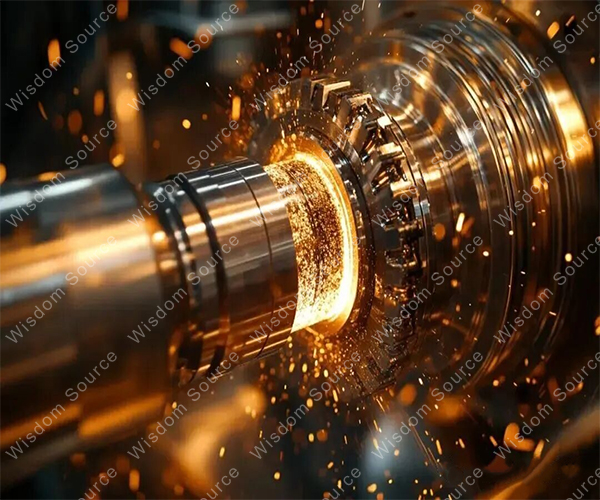Titanium Alloy Classification, Processing And Grinding Characteristics And Technological Innovation
Titanium Alloy Classification, Processing And Grinding Characteristics And Technological Innovation
Titanium alloy has important applications in many fields because of its unique properties, but it has many challenges in processing and grinding. An in-depth understanding of the classification, processing technology characteristics, grinding characteristics and grinding technology innovation of titanium alloys is of great significance to promote the wide application of titanium alloys and the optimization of processing technology.
1. Classification Of Titanium Alloys
In 1956, McGovern strictly distinguished titanium alloys based on the differences in annealed states, and divided them into three categories: α, β, and α + β.Among them, TC4 (Ti-6Al-4V) belongs to the α + β phase structure, which is the most widely used titanium alloy with the most comprehensive performance data.Aluminum and vanadium are the main alloying elements of TC4(Gr5). Aluminum is the α-stabilized element and vanadium is the β-stabilized element, which together give TC4(Gr5) excellent properties.
2. Processing Process Characteristics
TC4(Gr5) titanium alloy is extremely difficult to process, which is mainly due to its significant differences in crystal structure, physical properties and chemical properties with steel, aluminum alloy and many heavy metals, which are specifically reflected in the following three aspects:

1) Unstable Chemical Composition
When TC4(Gr5) titanium alloy is thermally deformed, it will react chemically with oxygen, nitrogen and some oxygen-containing gases to generate oxide skin on the surface of the workpiece. When the temperature exceeds 900℃, the oxide skin will form scales, causing oxygen and nitrogen to penetrate and diffuse into the metal, and finally form a surface suction layer with high hardness and low plasticity.
2) Cementite Characteristics
Cementite is manifested as a complex Fe-C compound in the metallographic structure, and its Vickers hardness can reach up to about HV1100, but the impact toughness is extremely low, almost zero. This characteristic has a certain impact on the processing performance of TC4 titanium alloy.
3) Poor Thermal Conductivity
Compared with other alloys such as aluminum alloy, the thermal conductivity of titanium alloy is only about 1/15 of aluminum alloy and about 1/5 of steel; the temperature conductivity is only about 1/15 of aluminum alloy and about 2/7 of steel. The lower thermal conductivity and temperature conductivity have a greater impact on the surface processing quality of titanium alloy parts.
3. Grinding Characteristics
Because titanium alloy has the characteristics of high strength, good thermal stability, high high temperature strength, high chemical activity, low thermal conductivity, and low elastic modulus, it is extremely difficult to grind and is one of the most difficult materials to process, which seriously limits its popularization and application scope.The main grinding characteristics of TC4(Gr5) titanium alloy are as follows:
1) The Grinding Wheel Bonding Problem Is Serious
During the grinding process, the surface of the grinding wheel will adhere to the titanium alloy, and the bonded surface will be smoke-like. The loss of the adhesion will cause the abrasive particles to break and fall off, which will seriously damage the grinding wheel.
2) High Grinding Force And High Temperature
The grinding test of a single abrasive particle shows that the slippage process is relatively large when grinding titanium alloy. The contact time between the abrasive particles and the workpiece is short, but severe friction and elastic and plastic deformation will occur, resulting in a lot of grinding heat, and the grinding temperature can reach up to about 1500℃.

4. Special Chip Shape
When grinding titanium alloys, layered extruded chips are formed, while ribbon chips are formed when grinding 45 steel with a white corundum grinding wheel (WA60KV).
5. Strong Chemical Activity
Under high temperature conditions, TC4(Gr5) titanium alloy is chemically active and easily reacts violently with oxygen, nitrogen, hydrogen and other elements in the air to form brittle and hard metamorphic layers such as titanium dioxide, titanium nitride, and titanium hydride, reducing the plasticity of titanium alloy.
6. The Workpiece Is Easily Damaged
During the grinding process, the grinding heat transmitted to the workpiece is difficult to export, which can easily cause deformation, burns and even cracks of the workpiece, increasing the surface roughness of the workpiece.
7. Grinding Technology Innovation
1) Inhibit Grinding Burns And Cracks
In view of the adhesion phenomenon in the processing of TC4(Gr5) titanium alloy and the resulting surface burns and cracks, Ren Jingxin and others found through experimental research that softer grinding wheels, such as silicon carbide or cerium silicon carbide grinding wheels (ceramic adhesion is used, while corundum grinding wheels use resin adhesion). At the same time, the processing parameters should be reasonably controlled. The grinding wheel speed should not exceed 20 meters per second, the grinding depth should not exceed 0.02mm, and the workpiece movement speed should be controlled at 12-16 meters per minute.In addition, the grinding fluid should have good heat dissipation and lubrication effects. When dry grinding, a grinding wheel impregnated with solid lubricant can be used to effectively suppress the bonding phenomenon.
2) Suppression Of Grinding Wheel Bonding Phenomenon
During the grinding process of titanium alloy, the higher grinding temperature and greater normal force will cause severe plastic deformation of the titanium alloy in the grinding area, and the bonding effect between the abrasive and the metal will be produced by physical or chemical adsorption. The shear force will cause the ground metal to transfer to the abrasive particles, causing the grinding wheel to bond, and eventually break the abrasive particles. When the grinding force exceeds the binding force between the abrasive particles, the abrasive particles and the binder will be peeled off from the grinding wheel.
